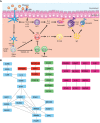Asthma and the Missing Heritability Problem: Necessity for Multiomics Approaches in Determining Accurate Risk Profiles
- PMID: 35693821
- PMCID: PMC9174795
- DOI: 10.3389/fimmu.2022.822324
Asthma and the Missing Heritability Problem: Necessity for Multiomics Approaches in Determining Accurate Risk Profiles
Abstract
Asthma is ranked among the most common chronic conditions and has become a significant public health issue due to the recent and rapid increase in its prevalence. Investigations into the underlying genetic factors predict a heritable component for its incidence, estimated between 35% and 90% of causation. Despite the application of large-scale genome-wide association studies (GWAS) and admixture mapping approaches, the proportion of variants identified accounts for less than 15% of the observed heritability of the disease. The discrepancy between the predicted heritable component of disease and the proportion of heritability mapped to the currently identified susceptibility loci has been termed the 'missing heritability problem.' Here, we examine recent studies involving both the analysis of genetically encoded features that contribute to asthma and also the role of non-encoded heritable characteristics, including epigenetic, environmental, and developmental aspects of disease. The importance of vertical maternal microbiome transfer and the influence of maternal immune factors on fetal conditioning in the inheritance of disease are also discussed. In order to highlight the broad array of biological inputs that contribute to the sum of heritable risk factors associated with allergic disease incidence that, together, contribute to the induction of a pro-atopic state. Currently, there is a need to develop in-depth models of asthma risk factors to overcome the limitations encountered in the interpretation of GWAS results in isolation, which have resulted in the missing heritability problem. Hence, multiomics analyses need to be established considering genetic, epigenetic, and functional data to create a true systems biology-based approach for analyzing the regulatory pathways that underlie the inheritance of asthma and to develop accurate risk profiles for disease.
Keywords: GWAS - genome-wide association study; asthma; epigenetics; inheritability; maternal inheritance, atopic disease; microbiome and dysbiosis; multiomics approach.
Copyright © 2022 Augustine, Al-Aghbar, Al-Kowari, Espino-Guarch and van Panhuys.
Conflict of interest statement
The authors declare that the research was conducted in the absence of any commercial or financial relationships that could be construed as a potential conflict of interest.
Figures



